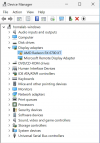GPU is Sapphire Pulse RX 6700 XT
I followed this guide loosely, everything worked till the last step. The GPU is detected by Windows, AMD driver installation appears to be successful, no errors whatsoever but for some reason the GPU still has that small exclamation mark in device manager. I can confirm graphic acceleration is not working because I only get single digit FPS in this WebGL test (not the best benchmark I know : ) ).
A few things I've tried:

I feel it must be something minor but I'm out of clues... Any ideas?
I followed this guide loosely, everything worked till the last step. The GPU is detected by Windows, AMD driver installation appears to be successful, no errors whatsoever but for some reason the GPU still has that small exclamation mark in device manager. I can confirm graphic acceleration is not working because I only get single digit FPS in this WebGL test (not the best benchmark I know : ) ).
A few things I've tried:
- Connect the card to a monitor because some posts say it can't be unplugged.
- Enable GPU rendering over RDP in group edit. (I'm connecting to the VM via RDP)
- Different driver installations, driver only, minimal, full install
- Grub command line, added:
intel_iommu=on iommu=pt initcall_blacklist=sysfb_init - Kernel modules loaded:
vfio, vfio_iommu_type1, vfio_pci, vfio_virqfd - Kernel module options:
vfio_iommu_type1 allow_unsafe_interrupts=1vfio_pci disable_vga=1vfio_pci enable_sriov=1vfio_pci ids=8086:4680,1002:73df,1002:ab28kvm ignore_msrs=1kvm report_ignored_msrs=0
- Blacklisted video drivers:
amdgpu, radeon - Enabled SRIOV in BIOS (tried iGPU passthrough but failed, Alder Lake CPU).
Code:
# qm config 3000
balloon: 4096
bios: ovmf
boot: order=scsi0;ide2;net0
cores: 8
cpu: host
efidisk0: local-zfs:vm-3000-disk-0,efitype=4m,pre-enrolled-keys=1,size=1M
hostpci0: 0000:03:00,pcie=1,x-vga=1
ide2: none,media=cdrom
machine: pc-q35-7.0
memory: 16384
meta: creation-qemu=7.0.0,ctime=1668754724
name: windows
net0: virtio=AA:97:D8:C6:1C:6A,bridge=vmbr0,firewall=1
numa: 1
ostype: win11
scsi0: local-zfs:vm-3000-disk-1,backup=0,cache=writethrough,discard=on,size=60G
scsihw: virtio-scsi-pci
smbios1: uuid=4c9ee8ce-cb9f-479c-8386-07cd616bf476
sockets: 1
tpmstate0: local-zfs:vm-3000-disk-2,size=4M,version=v2.0
vga: none
vmgenid: a7b35231-f456-4539-9e04-441649f01f7a
I feel it must be something minor but I'm out of clues... Any ideas?
Last edited:

